
Sri Sankara's (Shankaracharya) Teachings In His Own Words
Book Specification
| Item Code: | IDE081 |
| Author: | Swami Atmananda |
| Publisher: | Bharatiya Vidya Bhavan |
| Language: | English |
| Edition: | 2020 |
| ISBN: | 9788172765491 |
| Pages: | 270 |
| Cover: | Paperback |
| Other Details | 7.2" X 4.8" |
| Weight | 230 gm |
Book Description
Swami Atmananda was born in Chittur-Cochin, had his education in the Local High School and Government Victoria College, Palghat and Christian College, Madras and was in the educational service till 1930.
Actively engaged in Congress work since 1919 he came into close contact with Gandhiji in 1916 at Madras. He was at the Vaikom Camp as Gandhiji's personal Assistant during his kerala tour. Similarly, he acted as Secretary to Malaviyaji during his Kerala tour in 1917. He participated in the Salt Satyagraha Movement launched by Gandhiji and suffered imprisonment. He was the President of the Cochin state Praja Mandal for many years. In that capacity he participated in the A.I.C.C. Meeting at Bombay in 1942 and was arrested on his return to his State. It was while in Jail that he arranged the thoughts of Sankara found scattered in Prathanatraya. He continued as President of the Praja Mandal till 1950. except for a short break.
From August 1934 he was an honorary worker in the Madras Ramakrishna Mutt. At the end of 1950 he became a Sanyasin, a disciple of Swami Ramdas of Anand Asram, Kanhangad, Kerala. Since then, he is the Acharya of the Veda Sastra Patasala. Chittur-Cochin, where he has reorganized the Vedic Studies by adding to them instructions in modern subjects as well. He was the President of the Bharat Sadhu Samaj, Kerala Branch.
Many have tried to interpret Sankara-Vichar (the Philosophy of Sankara), some doing so in their own words, while others in those of Sankara himself. This small book of Swami Atmnandaji falls in the second category, though it has its own style which has present Sankara the commentator as Sankara the aphorist. Although a commentator, Sankara is never elaborate without purpose. His notes are the briefest. He gives the purport, in the beginning, in an aphorism -like sentence and elaborates and elucidates the same later. The author has herein tried to pick out some of the aphoristic sentences.
I have not gone through the book critically, but have seen the scheme adopted. It was at my instance that the author added some more Sutras to his original chapter on Upasana which otherwise would, I felt, do injustice to Sankara. The author who appreciated the suggestion wrote out the chapter anew. I am afraid, however, that due to haste, it might not have become so well-knit.
The whole subject has been summed up within three hundred and twenty Sutras. It is no easy task to confine the ocean-like wisdom of Sankara in a bottle, nor is that the author's claim. Only the salient points are meant to be indicated here. I hope the reader will approach the book from this viewpoint.
Since the attainment of Independence by India there are seen signs of a religious revival in the country. The advent of the Atom Bomb and the destruction it forebodes to the much-vaunted Western civilization has caused a depression in the Western mind. It is engaged in an anxious search for a way out. This may be taken as a prelude to a religious dawn in the West also. So it would be of great value to India and the West to understand a great master mind on religion to show them a new path of religious thought and practice in conformity with the times. Right comprehension is the father of right practice.
Possessed as I was with this great idea, I had a great desire that Sankara's teachings should be made available to the people at this moment. By God's grace, the Bharatiya Vidya Bhavan kindly undertook to publish my book and brought it out in November 1958. The fact that the first edition was exhausted in a few months only serves to confirm my idea that the thinking religious world did feel the necessity for such a book.
Sankara's genius is many-sided; so also are his works. As stated by Shri Vinobaji it is not an easy task to confine the ocean like wisdom of Sankara within the compass of a small book. But my aim is but a limited one; the aim of this book is only to present his ideas on the various phases of religious evolution. His ideas on religions are not local and topical but universal and for all times! So his assessment of the various phase of religious evolution, it is hoped, will be of great value and use to the modern aspirants in the practice of religion. Perhaps Shri Vinobaji's book on Sankara's "Guru Bodh" published in May 1957 is more comprehensive in outlook.
I have taken the opportunity of a second edition to try to improve the book in the light of certain criticisms about it. I have entirely recast the introduction to the first chapter to make the subject matter more lucid. This chapter has been re-named "The Vedas" (Scriptures) to indicate clearly what Sankara's contributions are for a right evaluation of the scriptures.
There are many questions about the necessity and validity of the Scriptures. The new introduction supplies to reply to these and shows how the Scriptures throw light on sphere of mind not still fully explored by Science. It is perhaps more necessary to know about the limitations and weaknesses of the Scriptures to appreciate them properly. It may be stated here that Sankara has very valuable observations to make on both these aspects of the Scriptures. Though these are made in reference to the Vedas, they are equally applicable to all the Scriptures of the world. That is why the more general name "SCRIPTURES" has been adopted for this chapter. Two new sections as Arthavada, and Itihasa and Puranas have been added.
A new section has been inserted in the introduction to the introduction to the second chapter under the heading "Why the topic of Nitya-karmas now-a-days?" The Vedic Nityakarmas, typified by Agnihotra and confined to the Brahmins in the old days, have now gone out of use. But a lot has been said in the book about Sankara's views on Nityakarma. Is this necessary? Yes. Even to-day people in every section of society and in every religious group are firm believers that certain ceremonies have to be regularly gone through. Their attitude to these ceremonies is not unlike that of Jaimini's; for Jaimini's mind is typical of a large class of religious people who believe that with the meticulous performance of certain ceremonies, the religious practices are exhausted and that there is nothing more to do in religion.
At best it may be said of these people that they do not know about the higher phases in the evolution of religion, It will be good for them to know what Sankara's views are on their attitude and practices. Sankara throws a flood of light on the limited value of ceremonies by his remarks on Nityakarma.
The sayings of Sankara on Mantra Japa and Varna Dharma added at the end of chapter IV may be of interest to the curious layman.
This book is not intended merely for scholars, but for a wide circle of general readers who have at least a bias towards religion or have the curiosity to know what the great Sankara's teachings are.
Sankara's status in the religious and philosophical world is similar to that of Einstein in the world of science. How many can take easily to a popular exposition of the principles of Relativity and understand it without some scientific background? Not even so much of background about religious ideas is expected of the general reader here, as every one is vitally interested in questions of his happiness and is making some endeavour to come by it. In this book is depicted the way to that happiness. The book also gives a proper assessment by Sankara of the various stages on the way to the goal.
Various topics are taken up in each or the chapters. The points of each topic have been emphasised and hammered in by an array of quotations bearing on it. This repetition may prove very annoying to some readers. To such whose curiosity is only intellectual and as such cannot stand this repetition, is suggested the reading of the introductions to each chapter and the reading of one or two sayings on each topic. The long notes in the body of the book may also prove instructive.
It may be added that the purpose of emphasis by repeated quotations is to point out that any observation of Sankara is not quite casual but deliberate and sustained. Further, some sayings bring out subtle aspects not dealt with in others. This work will prove especially useful to those who want to have very clear ideas in their practice of higher religion by Japa and meditation.
Shri Vinobaji gave his foreword in Hindi and it was to have been published in the original as well as in translation but the Hindi original somehow came to be omitted. This as well as an appendix, glossary and index, omitted in the first edition, have been added here.
In the following pages are given typical sayings of Sankara in original with their translation in English with notes where necessary. The sayings have been culled from his commentaries on the Prasthana Trayi (the Upanishads, Gita and Brahma Sutras) and arranged under various topics. An attempt has been made to follow the psychological sequence.
The aim of Part I (this book) is to introduce the reader to the fundamental aspects of Sankara's teaching in their easiest form, so as to make him comprehend Hinduism in its purest and simplest form. But, in fact, Sankara is so general in his statements that his teachings will profit the followers of all religions equally.
The method adopted by Sankara in establishing the great propositions of religion is almost parallel to that adopted in Geometry. He opens any discussion by stating his proposition first, in the most pithy yet precise form. Using a Sanskrit word, we may state that he states his case tersely as if in a "Sutra." Then arguments against an for are adduced elaborately, with a wealth of detail and rigorous reasoning. No aspect of the question is left out. Cutting his way straight and sharp through the maze, the propositions are proved to the hilt and established. This portion of the argument forms the elaborate explanation of the initial terse statement or Sutra. Part I contains some of the most important "Sutras" of Sankara with a view to introducing him to the lay reader. The elaborate explanations are not given here as they will interest only the few serious readers who would like to go into these propositions more fully. They may find their satisfaction in Part II, which it is hoped to publish later.
Sankara has to be known in India itself much more widely. Nothing else will be so life-giving and invigorating to the thinking part of the nation. No better antidote to the prevailing super-stitions in the very vital field of religion can be thought of. As all may not have the patience or the grounding required to follow with relish a strict course of reasoning, it has been thought better to place before them the bare bold propositions of Sankara on religion. Sankara should to merely be revered and admired but what is more important is that his thoughts and teachings should be more intimately and authoritatively known.
There is another advantage in presenting the "Sutras" (bare propositions of Sankara) first. It will be like the study of the map of a new city before one goes out to see it actually. This will insure against the path or the bearing being lost in the mazes of the city. It is better that a hold is obtained on the fundamentals of a subject before one launches oneself into its intricacies, Further, in these days of haste and hurry, a book, small in size yet giving the essential and salient features, will generally be more welcome.
The whole subject has been classified under four major heads: the Vedas (Scriptures); Karma (primarily rituals); Upasana (meditation to achieve prosperity) and Jnana Nishtha (meditation to realize Truth or God). Karma and Upasana constitute the Pravritti Marge (the path circling outwards). They are methods inevitably adopted, while on is in the initial stages of religious experience. Though there is ceaseless activity, that cannot free us from the bounds of Slavery to Nature. Here the Devas and even God himself are but the means; one's prosperity and enjoyment, the end. Jnana Nishtha constitutes the Nivritti Marga (the path circling inwards). The man who was till now an extrovert now becomes an introvert. Now God becomes the end. Armed with right knowledge and ethical excellence, the march is straight on to the goal of Atman or God.
The factors and details of Karma, Upasana and Jnana are prescribed by the Pramanas which, for the Hindu religion, are the Vedas or the Srutis. This book will serve to throw light on the theory and practice of the Hindu religion. It is fundamental in this context to have a correct idea of place of the Sastras, and of the vital division of the passages of the text into two broad categories as Vidhis and Arthavadas or as Vakyas and Vakyaseshas. This is the great contribution of Acharya Jaimini in his Mimamsa Sastra.
In regard to practice, the relative values of the three stages of its psychological growth Karma, Upasana, and Jnana Nishtha have to be carefully borne in mind. The stages of karma and Upasana have to be outgrown to attain to Jnana as one has to outgrow his childhood and boyhood, the inevitable stages in a man's life, to attain his manhood. Sankara is a pastmaster is both the theory and the art of development of human personality until it bursts its shell of body and mind and expands into the whole universe. This development of personality is to be attained by Jnana, a new Superconscious insight. That is why it is called the third eye of Siva, which destroys all ignorance and illusion. That this Jnana can be attained by Bhakti or Raja Yoga as well is the firm conviction of the Bhagavad Gita as well as of Sankara.
A few of the sayings recur in more than one chapter or section. These have been repeated in order to make the make the ideas relating to each section complete.
| Kulapati's Preface | vii | |
| Prasthavana by Sri Vinobaji | xi | |
| Foreword | xiii | |
| Author's Preface | xv | |
| Author's Preface to the Second Edition | xvii | |
| Preface | xxi | |
| General Introduction | xxxi | |
| List of Abbreviations | xxxix | |
| Chapter 1 | Sankara : His Life and Achievements Early Days; Recognition; The Candala Incident; Paramahansa Parivrajaka; The Funeral of his mother; Last Days; India is one: Sanskrit is the cement; Sankara and Sri Ramakrishna; Sri Sankara; Sankara's time; Revival of Hinduism; Sankara; Sankara and Buddha; Sankara, typical of Hindu Genius; Sankara and Mandana; Sankara's Contribution; Panchayatana Puja; His Great Commentaries; Establishment of Maths; Sankara had a Modern Scientific Mind; Sankara was many-sided; Ethics superior to Rituals; Sankara's Synthetic Genius; His Scientific Attitude; Why not understood.
| 1 |
| Chapter 2 | The Vedas - Scriptures: Their Source, Scope and Interpretation Why the Vedas (Scriptures) at all?; The New Source of Knowledge; Religion begins in Belief but ends in Experience; Mim msa - the Science of Interpretation of Texts; Sankara and Mimamsa; The Vedas not "Commands" of God; Pramanas in General; Sabda Pramana (Vedas) - Its Scope; Jnana Kanda; Limitations of Sabda Pramana (Veda); How Impersonal and Eterna; Understanding of the Meaning of Vedas Essential; Arthavada; Itihasa and Purana; Moral of Akhyayikas (Stories)
| 24 |
| Chapter 3 | Karma (Primarily Rituals) Introduction; Jaimini's prescription for Moksha; Why the Topic of Nitya Karma Now-a-Days?; Sankara and Quietism; Karma Yoga; Pravritti Karma - its urge; In Nature; Its Limitations; Fruits of Karma; Its opposition to Jnana; So Karma to be given up; Nitya Karma - Incentive not Sastra but Svabhava; Urge, as in other Karmas, is Kama; Omission causes no Pratyavaya; Nitya Karma has Phala (fruit); Phala within Samsara; Nitya Karma also to be given up; Nivriti Karma (Karma Yoga, the turn to Nivritti) destroys bondage
| 54 |
| Chapter 4 | Upasana (Meditation) Introduction; Vidya; Its Evolution; Upasana Versus Jnana; Apara Vidya and Para Vidya; Sagunopasana and Nirgunopasana; Pranava Vidya; Sandhyopasana; Nama Japa; Another purpose of Upasana; Upasana in general Part A - Still Pravritti Part B - To Nivritti
| 88 |
| Chapter 5 | Jnana Nishtha, Yoga of Knowledge Introduction; Steps in Jnana Nishtha; Ethics; Higher Meditation; Reality of the World; Avidya and Karma; Nitya Karma; Antithesis between Karma and Jnana; What to do? Sthita Prajna: the Beacon Light; Ethics essential; Personal effort (Purushakara) for self-control necessary: not rituals; Atman - a Self evident Entity; Why Sastra then?; Nature of Atman; Nature of Jnana; Steps to Atma Jnana; Jnana Paripaka; Jnana Nishtha; Its fruit a Drishta one; Mantra Japa; Mantra Japa; for how long?; Varna Dharma
| 134 |
| Chapter 6 | Maya and Advaita (Extracts) Introduction; The Eternal urge in Man for Happiness; Religion in ignorance of Atman; Pravrithi Dharma; Religion with Knowledge - Nivirthi Dharma; Importance of Ethics; The Great Truth - Atman; Some Upanishadic statements about Atman; The Proof of Atman; By Self-experience only; Atman the Witness; Atman from another analysis; Atman is Ananda; Ignorance and Knoledge-Co-exist: Maya; Unreal Superimposition; (Adhyasa or Avidya); Certain sastra too, progeny of Ignorance; Moksha Sastra too is for the ignorant; Vyvahara and Paramartha;' Meanings of Maya; Sankara's Delineation of Maya and Advaita; First Religious Practices are in Ignorance; Maya in Vyavahara also; Maya- Diversity in spite of unity.
| 181 |
| Appendix | 209 | |
| Glossary | 215 |

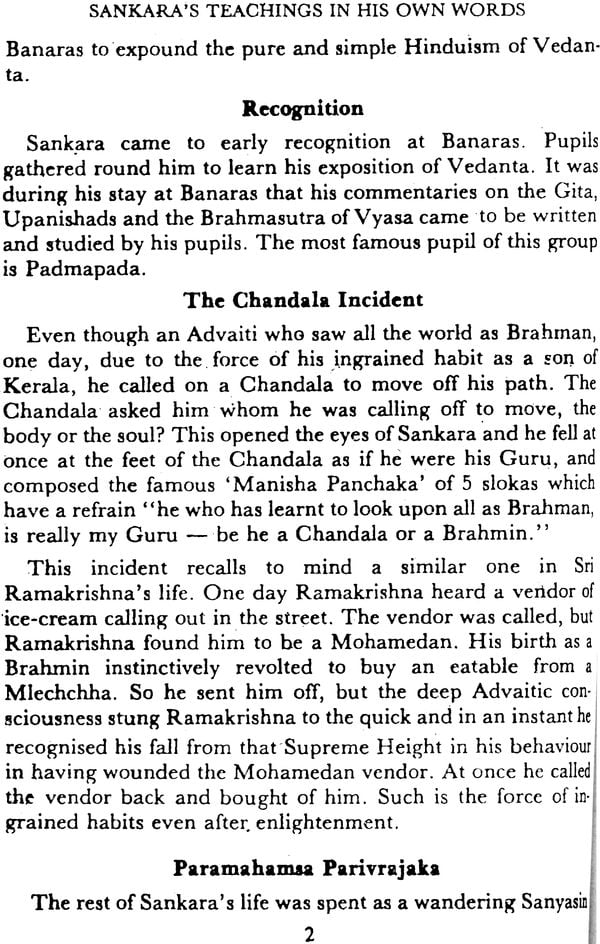
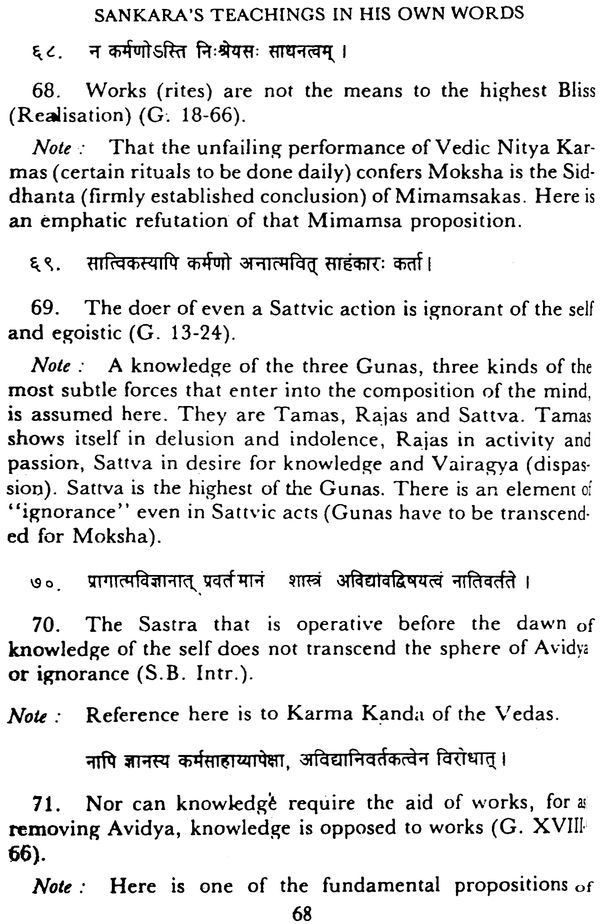
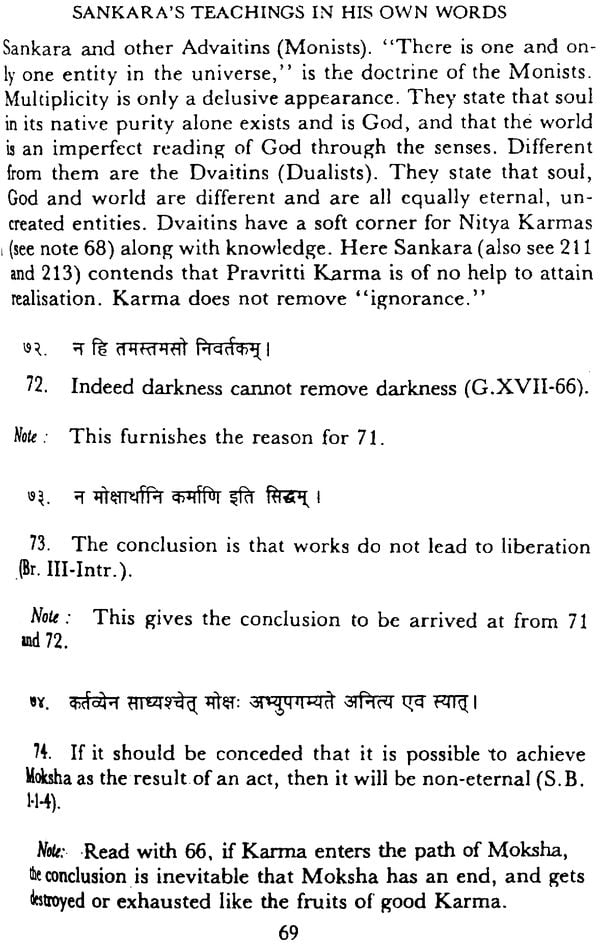
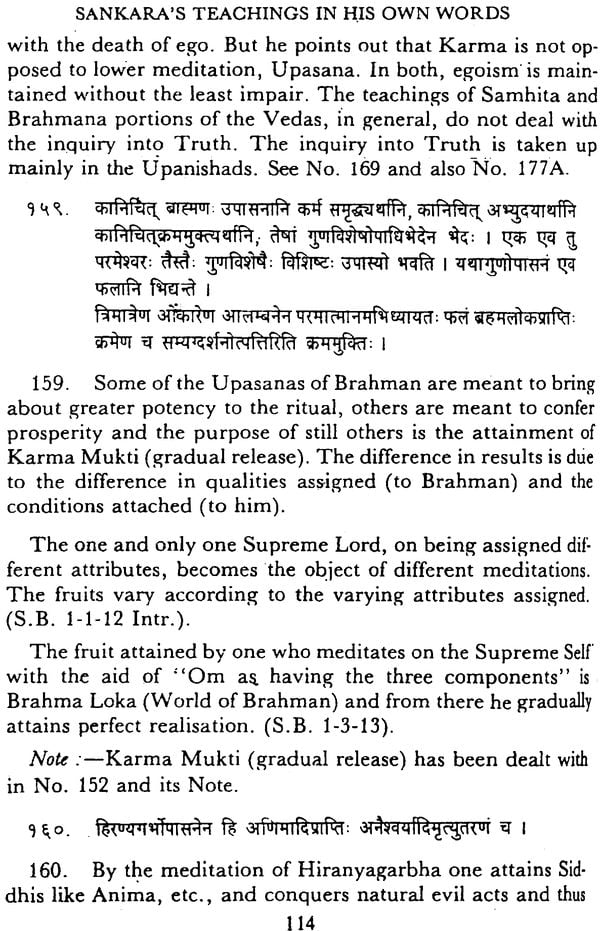

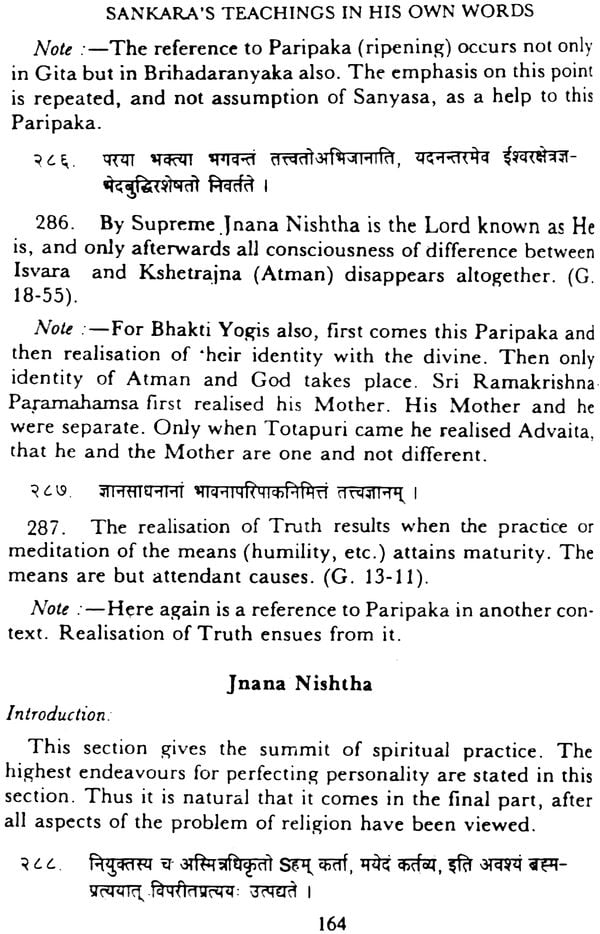
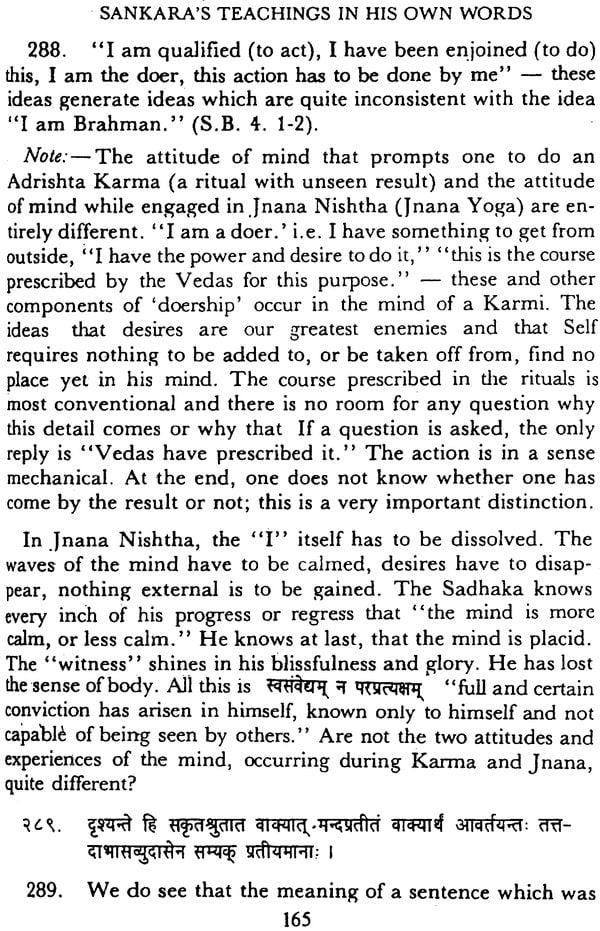
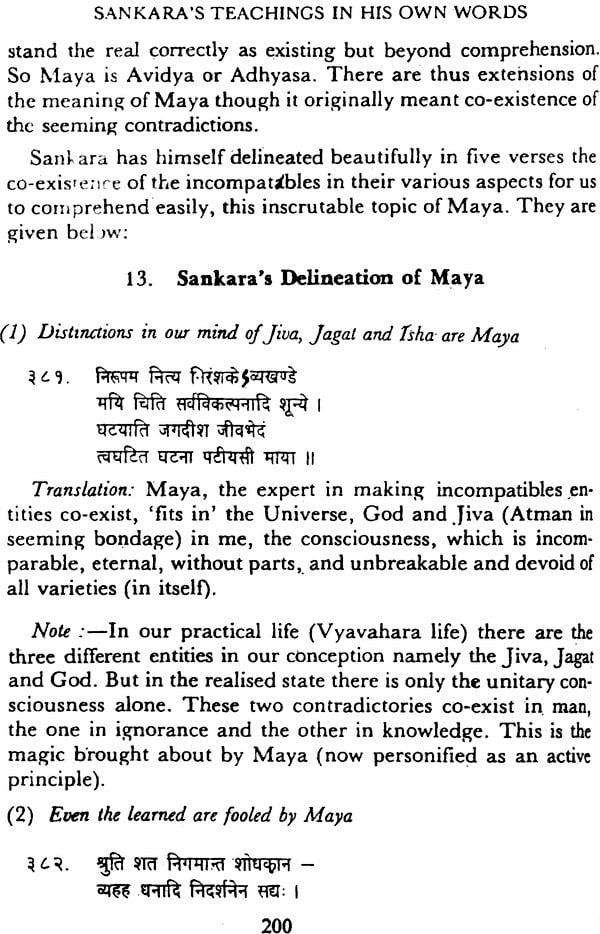

Of Related Interest:
Life of Shankaracharya - The Adventures of a Poet Philosopher
Click Here for an Exhaustive Collection of Books Relating to Shankaracharya





